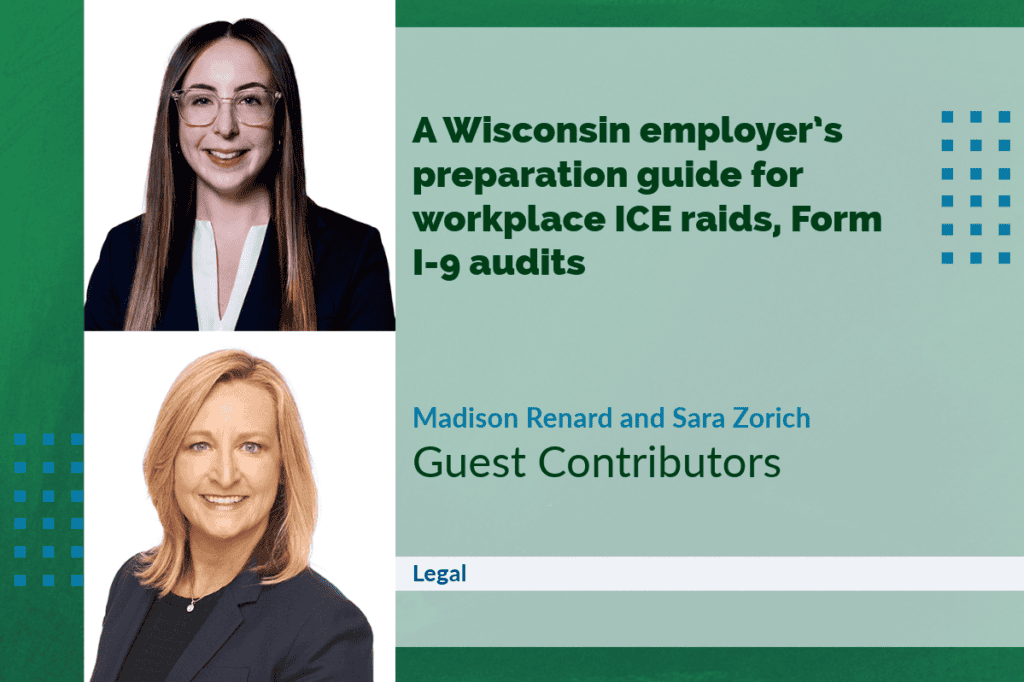
May 19, 2025
Early on in President Donald Trump’s second presidential campaign, he made his stance on immigration clear – take action against illegal immigration.
Since assuming office in January 2025, Trump’s administration has pursued a strict and aggressive immigration policy, aiming to significantly reduce illegal immigration by increasing deportations and expanding the scope of U.S. Immigration and Customs Enforcement (ICE) operations.
As a result, it is crucial for Wisconsin employers to understand their rights and responsibilities when it comes to ICE raids and Form I-9 audits.
Form I-9 audits
One way a Wisconsin employer may come in contact with ICE is through a Form I-9 audit, which is conducted by the Department of Homeland Security through Homeland Security Investigations (HSI) to:
- Verify the I-9 forms have been accurately and timely completed
- Ensure all employees have authorization to work in the U.S.
To begin the audit process, HSI is required to send the employer a Notice of Inspection.
This informs the employer of the inspection and its required compliance by providing HSI Form I-9 for either all or specifically listed employees.
In addition to the Form I-9, HSI may request other supporting documentation through a subpoena, such as a list of employees with hire and termination dates, tax and payroll records and information related to staffing agencies the employer utilizes.
In most instances, the employer will have three business days to turn over the requested documents to ICE.
However, employers may negotiate a longer period depending on the scope and number of employees involved in the audit.
HSI auditors then analyze the Form I-9 for substantive and/or technical violations.
Substantive violations refer to significant issues – such as incomplete, incorrect or missing forms, which can subject the employer to fines.
Technical violations are usually minor mistakes that can be remedied, and employers are typically given 10 days to correct any technical violations.
During the audit, the employer will also be notified of any employees for whom HSI has made a preliminary decision on who they have not provided documentation that establishes they are authorized to work in the U.S.
Employees are given an opportunity to contest HSI’s findings and provide new documentation, but if they are not able to establish that the employee can work in the U.S., the employer will not be able to continue to employ them.
When facing a Form I-9 audit, employers should work quickly to consult with their legal counsel and provide the requested information.
Recommended precautionary steps to prepare include:
- Conducting internal Form I-9 audits
- Reviewing existing Form I-9 audit procedures and confirming consistent and accurate procedures
- Training staff who complete the Form I-9 process and documentation regarding the proper steps and procedures to ensure compliance.
ICE raids
An ICE raid can be very intimidating to employers and employees.
Thus, it is important for an employer to have a plan in place and educate their employees on that plan.
When ICE personnel arrive at an employer’s facility, they are typically greeted by a receptionist or designated greeter.
It is essential that all receptionists and greeters receive proper training on how to handle encounters with ICE agents.
Receptionists should be trained to immediately contact a designated point person within the company who is familiar with the procedures for handling governmental officials.
After reaching out to the point person, the receptionist should politely ask the ICE agents to wait in a public area of the employer’s facility.
For example, ICE agents could be instructed to wait in the parking lot or lobby.
Unless the employer has given the receptionist or greeter permission to speak on behalf of the employer, the receptionist should not engage with the agents’ questions or permit them access to private areas of the facility.
Once the employer’s point person arrives, they should escort the ICE agents to a private room within the employer’s facility.
The point person will want to ask the ICE agents to clarify the reason for the visit and ask the ICE agents for names and badge numbers.
It is important for the point person to take notes on all information provided by the agents.
In addition to gathering personal information on the ICE agents, the designated point person will want to ask to copy any warrants, orders, subpoenas and other documentation that might state why the raid is being conducted.
All copied documents should be reviewed by legal counsel.
The point person will want to carefully read and review the documents provided by ICE before allowing the agents to move any further.
It is important for the point person to understand the rights and responsibilities associated with various types of warrants.
Judicial warrants
A judicial warrant must be signed by a judge and clearly indicate it was issued by a United States District Court or other applicable court.
The warrant should provide specific details, such as the name of the employee being sought, the specific records to be examined and the areas within the employer’s premises where ICE agents are authorized to enter.
The employer should review the administrative warrant with counsel to determine the scope and next steps.
Administrative warrants
An administrative warrant is issued by a federal agency rather than a U.S. District Court.
In most instances, an administrative warrant will have the name of the employee(s) ICE is looking for.
When presented with an administrative warrant, the point person is not required to produce the employee or allow a search of the employer’s premises.
The employer should review the scope of the administrative warrant with counsel to determine the next steps.
Employers should train and direct all staff to remain calm during an ICE visit.
If an employee is arrested during an ICE visit, they have the right to remain silent and request an attorney.
Immediately after a raid, an employer should record as much information as possible regarding the ICE visit.
For example, how many agents were present, their names, what the agents were wearing, if they spoke to any employees and if the employer believes there was any inappropriate behavior
on behalf of the agents (and if so, what was done/said).
The employer should work with their legal counsel for the next steps.
Conclusion
As immigration policies continue to focus on aggressive enforcement, it is essential for Wisconsin employers to be proactive in understanding their rights and responsibilities regarding ICE raids and Form I-9 audits.
By taking steps – such as conducting self-audits, reviewing procedures and training staff – employers can better prepare for potential inspections.
By staying informed and following proper procedures, employers can navigate the complexities of immigration enforcement.
 Hard work, determination lead self-taught baker to success, storefront
Hard work, determination lead self-taught baker to success, storefront Is Oshkosh on pace to reach its housing goals?
Is Oshkosh on pace to reach its housing goals?







